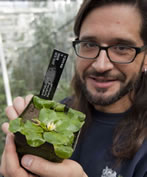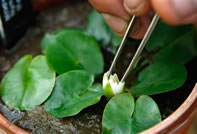Friday, May 21, 2010
Smallest Waterlily
- world record set
by
Nymphaea thermarum
Kew Gardens, London, UK -- Carlos Magdalena
,
a senior horticulturalist at the Royal
Botanic Gardens, Kew
has cracked the enigma of growing
a rare species of African waterlily, the 'thermal’ lily (Nymphaea
thermarum), with pads that can be as little as 1 cm in diameter
- setting the new world record for the Smallest
Waterlily
. 
Photo: Carlos Magdalena holding
Nymphaea thermarum, the world's
smallest waterlily
. Image: Andrew McRobb, RBG Kew
( enlarge
photo
)
“You can grow it in a coffee mug,” said Carlos Magdalena
, a senior horticulturalist at the Royal Botanic
Gardens, Kew
. “It makes an excellent houseplant.”
The plant, whose pads measure as little as 1cm across, is
less than a tenth of the size of the next smallest water lily.
Though the Rwandan Government will have
to give permission before the plant can be sold, Mr Magdalena
already has a market in mind: “I think the Japanese will go
crazy for it. They like lilies and they like bonsai.”
The world's
smallest waterlily
, whose lily pads can be as small
as 1cm across, is known as the "thermal water lily" because
it was discovered growing in the muddy edges of a freshwater
hot spring.
The smallest
water lily in the world
was discovered in 1985 and
was only known in one location in Mashyuza, Rwanda, from where
it disappeared around two years ago as water feeding the spring
was extracted for agriculture.
Professor Eberhard Fischer
, who discovered
the species Nymphaea
thermarum
, transported a few specimens to Bonn Botanic
Gardens, where horticulturists were able to preserve them
- but they proved extremely difficult to propagate. 
Photo: The leaves of Nymphaea thermarum
grow to be only a centimeter in size. Image credit: AP Photo/Alastair
Grant ( enlarge
photo
)
A handful of seeds and seedlings were sent to
the Royal Botanic Gardens, Kew, and were initially grown like
other water lilies, submerged in water, but failed to develop.
After a series of trials attempting to propagate
the species in different conditions, expert horticulturist
Carlos Magdalena finally solved the mystery of how to make
them grow - with the help of the original German description
of their natural habitat.
The species was found growing in damp mud
where the hot spring overflowed, and while water reached the
surface of the spring at 50C, it was 25C in the area the plant
had colonised. Mr Magdalena said he had tried growing the
seeds at different temperatures and water hardness and "nothing
seemed to work".
The only thing he had not manipulated was the
levels of CO2. "All the species of water lilies, and there
are around 50, start life deep in the water, so everyone was
trying that.
"Then I came across the description - they didn't
come from a river or lake - so I thought they may need the
CO2 in the air."
Down to his last batch of seeds from
Bonn, he tried the different technique, and "suddenly everything
came together", he said. The plants soon began to improve,
and eight water lilies flourished and grew to maturity. They
flowered for the first time in November 2009 and produced
seeds - with dozens of seedlings now growing at Kew.
The discovery of how to propagate the plant
came just in the nick of time, as the species had not only
vanished from its only known site in the wild but one of two
last remaining plants in Bonn was eaten by a rat. "Whenever
you have a plant and you can't propagate it you are doomed
to lose it," he said.
Luckily for the miniature water lily, the
code for its propagation has been cracked and its future -
at least in botanical collections - seems secured. He added:
"Our immediate priority is the ex situ conservation of the
species and thereafter, if the natural flow of water in its
historic location can be restored, plants grown at Kew can
then be reintroduced to the wild."
The world's largest water lilies
are blooming in a tropical greenhouse at London's
Kew Gardens
, too.
Subscribe to our RSS
News feed
to receive updates.
Related world records
:
Smallest
orchid-world record set by Lou Jost
Biggest
Mango - world record set by Sergio and Maria Socorro Bodiongan
Tallest
rose bush-world record set by Robert Bendel
Heaviest
gooseberry-world record set by Bryan Nellist
Tallest
Cactus-world record set by SDM College of Dental Sciences
Largest
rutabaga-world record set by Scott Robb
Largest
cabbage-world record set by Steve Hubacek
Largest
organic cucumber-world record set by the Segee family
Largest
potato-world record set by Khalil Semhat
Largest
rutabaga-world record set by Norm Craven
Longest
water spinach-world record set by Li Hui
Friday, May 21, 2010
Biggest
Mango-Sergio & Maria Socorro Bodiongan
Tallest
living Christmas tree-Coeur d'Alene
Longest
snake in captivity-Fluffy
Tallest
cat-Scarlett's Magic
Tallest
dog-world record set by Boomer
Tallest
Cactus-SDM College of Dental Sciences
Biggest
Largemouth Bass-Manabu Kurita
Biggest
Chicken Egg-"Titi"
